Physical Address
304 North Cardinal St.
Dorchester Center, MA 02124
Primary surgery for chronic rhinosinusitis is almost exclusively performed endoscopically.
Functional endoscopic sinus surgery (FESS) aims to restore mucociliary function by reestablishing physiologic sinus ventilation and drainage.
Surgery should be personalized. The extent of surgery depends on symptoms and the pathology.
“Large” hole surgery may be employed in certain disease states to optimize topical drug delivery.
Identification of anatomic landmarks and variations helps limit complications.
Major complications of endoscopic sinus surgery (ESS) include cerebrospinal fluid leak, blindness, diplopia, internal carotid artery injury, and death.
ESS provides significant improvement in overall and disease-specific quality of life.
Common causes of failure of ESS include lateralized middle turbinate, failure to incorporate maxillary ostium in the middle meatal antrostomy, maxillary ostium stenosis, frontal recess scarring, residual ethmoidal air cells, and adhesions.
A surgical approach to the maxillary sinus through its anterior wall was described in 1675 by Molinetti. In the 1890s, Caldwell, Spicer, and Luc added an additional opening into the sinus through the inferior meatus. The Caldwell-Luc procedures formed the primary surgical treatment of choice for chronic rhinosinusitis (CRS) through the early twentieth century. Although Hirschmann conducted the first endoscopic examination of the nose with a modified cystoscope in 1901, the modern era of endoscopic sinus surgery (ESS) evolved with the development of Hopkins rods in the 1950s. Messerklinger pioneered the study of the endoscopic anatomy and pathophysiology of the paranasal sinuses and published his experience with ESS in 1978. He highlighted the role of the ostiomeatal complex (OMC) in the pathophysiology of rhinosinusitis and directed attention to it during surgery. His then resident, Stammberger, was instrumental in popularizing this technique outside Germany and Austria, although Kennedy is credited with the introduction of ESS to the United States in 1985. With widespread availability of endoscopes and instrumentation and with focused training in endoscopic techniques, primary surgery for CRS is now almost exclusively performed endoscopically. External and intranasal nonendoscopic approaches have limited indications in primary ESS. Endoscopic techniques are now routinely being applied to the management of many non-inflammatory sinonasal disorders. The decision to operate and the extent of surgery are dictated by the patient's symptoms and the pathophysiology of the disease process. Surgery should, therefore, should be personalized and tailored to address disease unique to the patient. Surgery must only be undertaken after a thorough review of patient expectations, surgical anatomy, and endoscopic review of the nasal and sinus pathology, and, generally, after failure of appropriate medical therapy.
Identification of anatomic landmarks and recognition of variations are imperative to maximize benefits and limit complications from ESS. This chapter offers a concise review of the relevant endoscopic surgical anatomy. The surgeon must also be familiar with external landmarks and with the three-dimensional spatial orientation. Standardized nomenclature based on the recommendations of the Anatomic Terminology Group at the International Conference on Sinus Disease and the recent European Position Paper on the Anatomical Terminology of the Internal Nose and Paranasal Sinuses are used in this chapter.
The OMC ( Fig. 44.1 ) is a functional concept rather than an anatomic structure with defined boundaries. It represents the final common pathway for drainage and ventilation of the ethmoidal, maxillary, and frontal sinuses. Although the OMC's exact boundaries are not defined, it comprises structures bound between the medial orbital wall and the middle turbinate. The OMC comprises the uncinate process, ethmoidal infundibulum, hiatus semilunaris, anterior ethmoidal cells, and the ostia of the anterior ethmoidal, maxillary, and frontal sinuses (see Fig. 44.1 ).
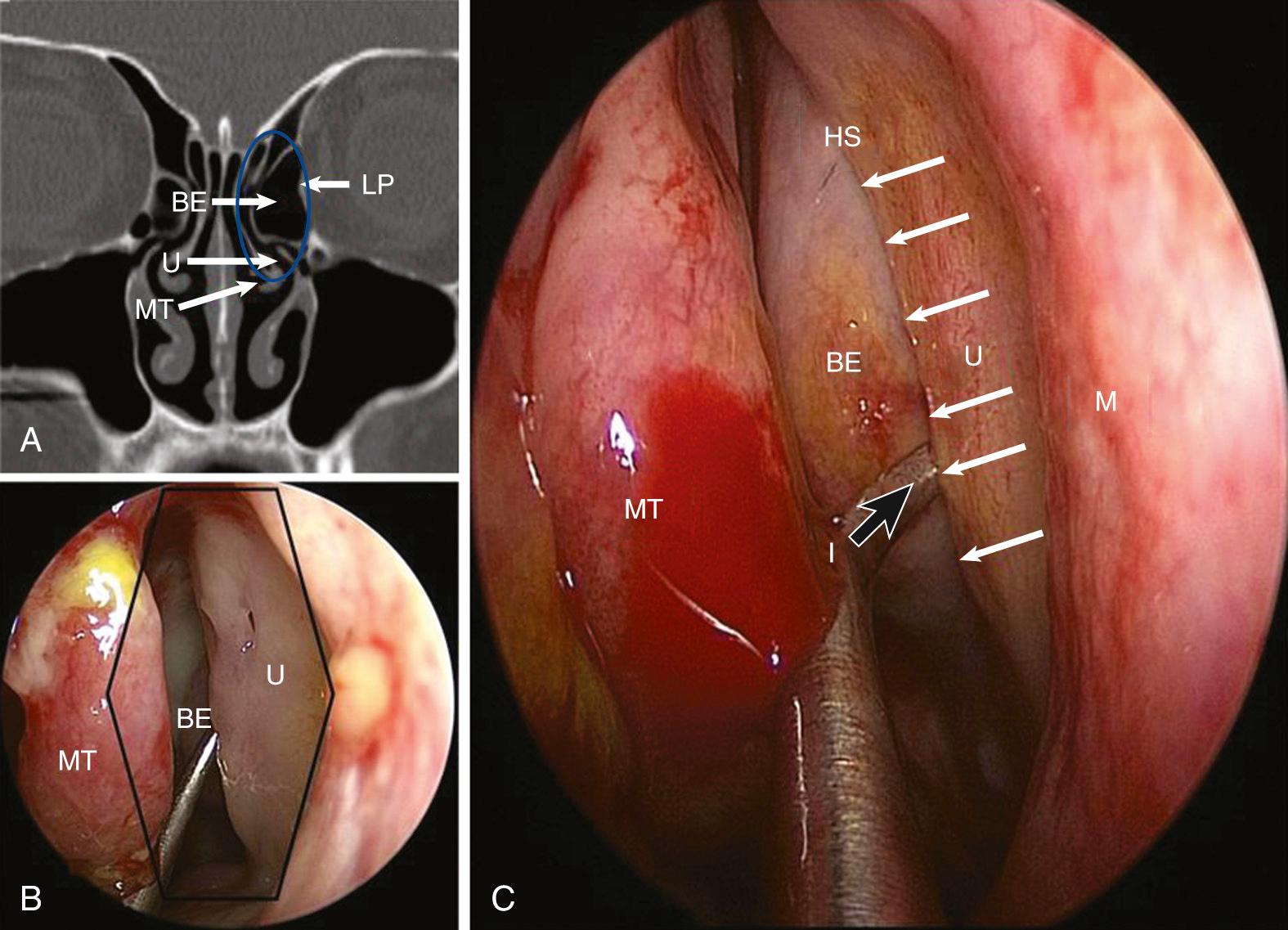
The uncinate process is the first structure encountered in the middle meatus when the middle turbinate is medialized. It is a sickle-shaped bone that runs anterosuperior to posteroinferior, with fibrous and bony attachments along the lateral nasal wall. It lies in the sagittal plane and forms the medial wall of the ethmoidal infundibulum. The ethmoidal infundibulum is a funnel-shaped three-dimensional space between the uncinate process medially and the lamina papyracea laterally, into which the anterior sinuses drain. The maxillary sinus opens into the inferior aspect of the ethmoidal infundibulum at a 45-degree angle, and the frontal sinus may drain into its superior part. The inferior semilunar hiatus, commonly referred to as the hiatus semilunaris , is a two-dimensional slit that lies between the free edge of the uncinate process and the ethmoidal bulla. It is a cleft that connects the middle meatus into the infundibulum laterally. The infundibulum is surgically accessed from the nose by a probe passed through the hiatus semilunaris.
The superior attachment of the uncinate process has implications on the drainage of the frontal sinuses. The uncinate process may attach either to the lamina papyracea, the skull base, or the middle turbinate ( Fig. 44.2 ). When the uncinate attaches to the skull base or middle turbinate, the frontal sinus drains into the superior aspect of the infundibulum. However, more commonly, the uncinate process attaches laterally to the orbit below the internal frontal ostium, forming a terminal recess (recessus terminalis) . In this case, the frontal sinus drains medial to the uncinate process into the middle meatus and not into the ethmoidal infundibulum. The uncinate may actually have multiple attachments to the orbit, middle turbinate, and skull base; the above statements are meant to simplify understanding how frontal recess drainage may be affected by these uncinate attachments. The uncinate process must be removed to gain access to the anterior ethmoidal sinuses, the maxillary sinus, and the frontal recess. Its posteroinferior portion overlies the maxillary sinus ostium and must be removed to identify the natural maxillary ostium.
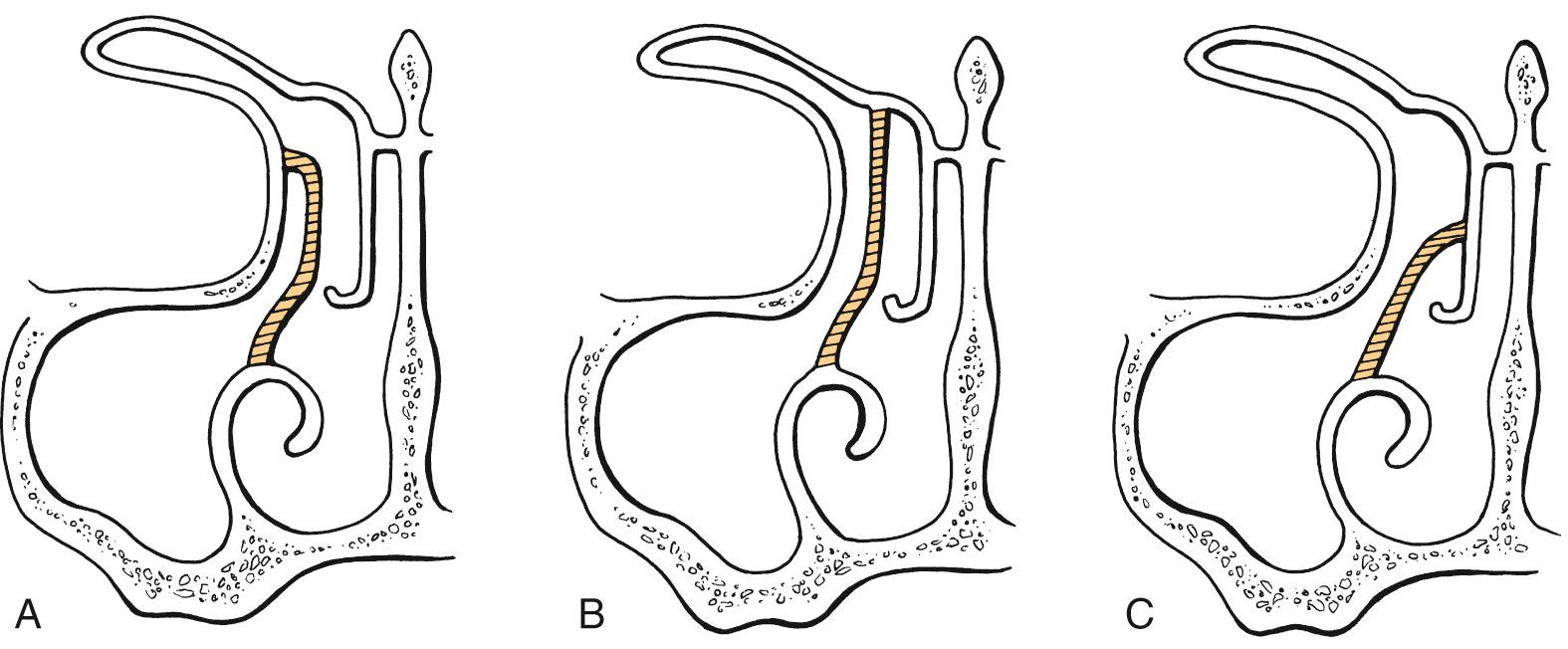
The middle turbinate (MT) is a boomerang-shaped structure ( Fig. 44.3 ). The MT basal lamella is the entire MT attachment to the lateral nasal wall and skull base. The MT basal lamella can be conveniently thought of in three parts from the anterior to posterior aspects. The part that is first encountered during nasal endoscopy is the vertical part, which attaches to the agger nasi region anteriorly and then to the cribriform plate superiorly. This part is oriented in the sagittal plane. The second part has an oblique orientation in the coronal plane, which attaches to the medial orbital wall. The third and most posterior part, often referred to as the horizontal basal lamella, is its posterior buttress, lying in the axial plane and attaching to the lateral nasal wall at the lamina papyracea, maxilla, and perpendicular process of palatine bone. The oblique part of the basal lamella is the only part of the MT that can be sacrificed without compromising the integrity of the turbinate. If the vertical or horizontal attachment is injured, the MT will lateralize and scar down the middle meatus and posterior ethmoidal complex.
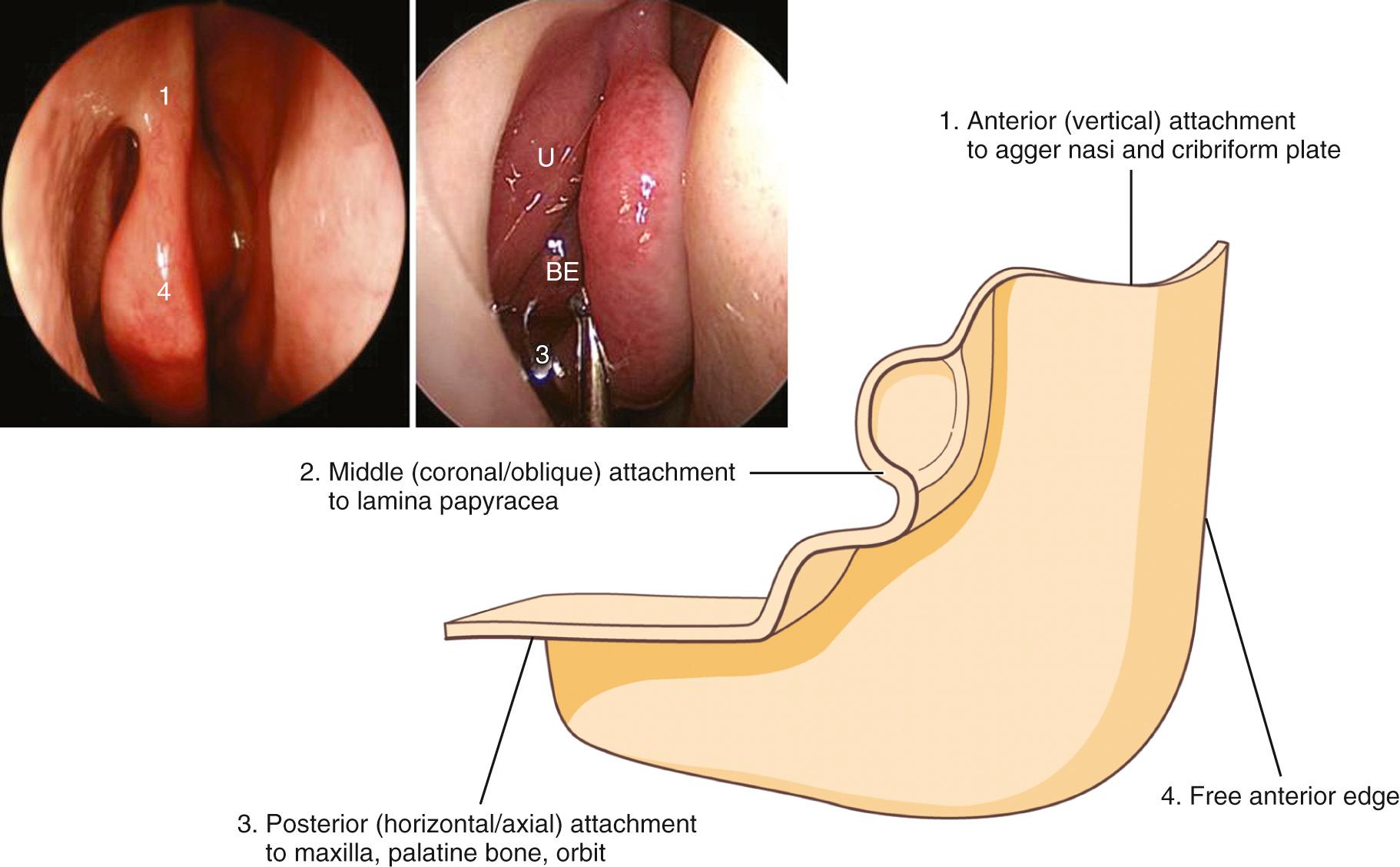
The ethmoidal complex is divided by the oblique part of the MT basal lamella into the anterior and posterior ethmoidal cells ( Fig. 44.4 ). Any cell that drains into the middle meatus is considered an anterior ethmoidal cell , and those that open into the superior meatus are posterior ethmoidal cells . There are no middle ethmoidal cells. Sometimes, ethmoidal cells pneumatize toward adjacent sinuses and impact their drainage, extending into the maxillary sinus (infraorbital or Haller cell), frontal recess (frontoethmoidal and supraorbital cells), and the sphenoid sinus (sphenoethmoidal or Onodi cell).
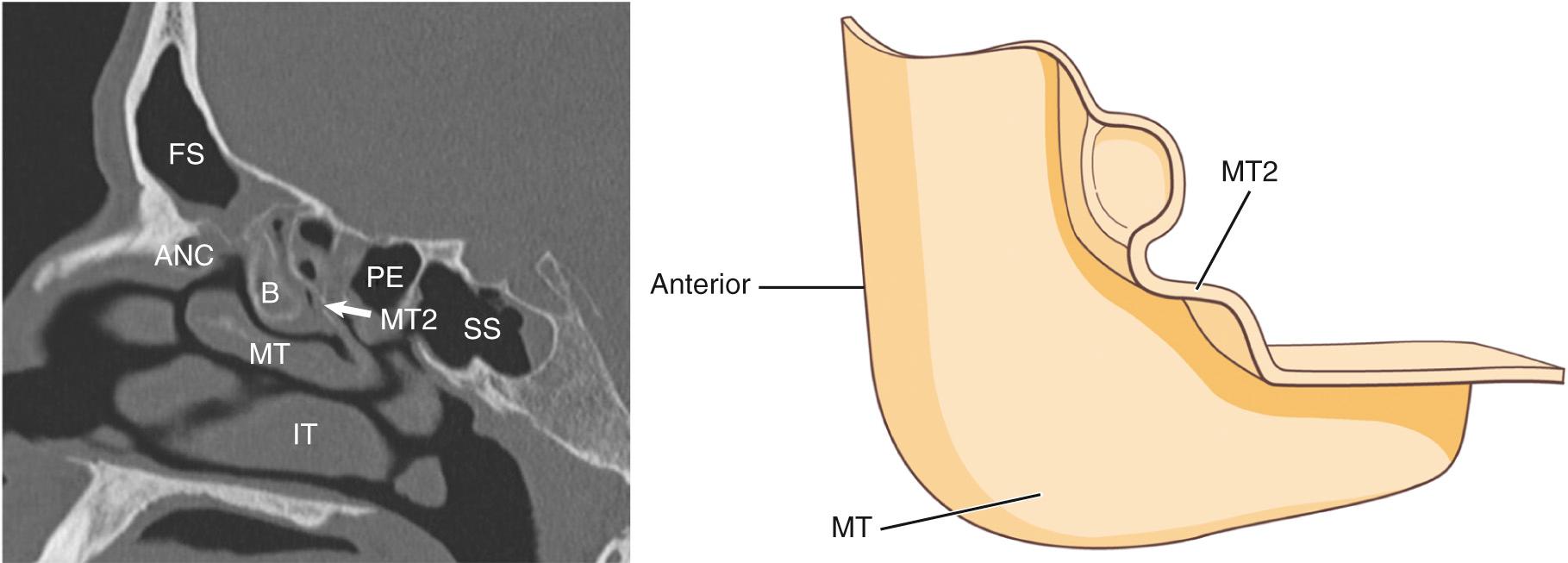
The ethmoidal bulla is an anterior ethmoidal cell, and it is the largest and most prominent cell of the ethmoid complex. It is the first cell encountered posterior to the uncinate process during entry into the anterior ethmoidal complex. Frequently, the ethmoidal bulla has a bony attachment to the skull base, the bulla lamella. The lateral wall of the ethmoidal bulla is the medial wall of the orbit, and it drains into the suprabullar or retrobullar recess ( sinus lateralis ; the combination of the suprabullar and retrobullar recess). The suprabullar recess and the retrobullar recess are clefts, rather than cells, bordered superiorly by the ethmoidal roof, laterally by the lamina papyracea, inferiorly by the roof of the ethmoidal bulla, and posteriorly by the basal lamella. The superior hiatus semilunaris, or hiatus secondarius , is the two-dimensional space that connects the middle meatus into these recesses.
The agger nasi is a bony mound on the ethmoid situated at the attachment of the middle turbinate to the lateral nasal wall. When the agger nasi is pneumatized, it forms the agger nasi cell (ANC; Fig. 44.5A ). The ANC is the most anterior of all ethmoidal cells and one of the most constant, occurring in 98.5% of computed tomography (CT) scans. The ANCs have a close relationship with the nasolacrimal drainage system, lying just posterior to the superior aspect of the nasolacrimal duct and the lacrimal sac. On endoscopy, the cell appears as a projection of the lateral nasal wall anterior to, or at the attachment of, the middle turbinate. The ANC is key in frontal sinus surgery. It may pneumatize so far superiorly into the frontal sinus as to be mistaken for the sinus itself when viewed endoscopically from below. A common mistake is to remove the floor and posterior cell wall, leaving the cap or dome of the cell lying in the frontal recess. Likewise, a partially resected ethmoidal bulla lamella can also scar the frontal recess leading to iatrogenic frontal sinus obstruction.
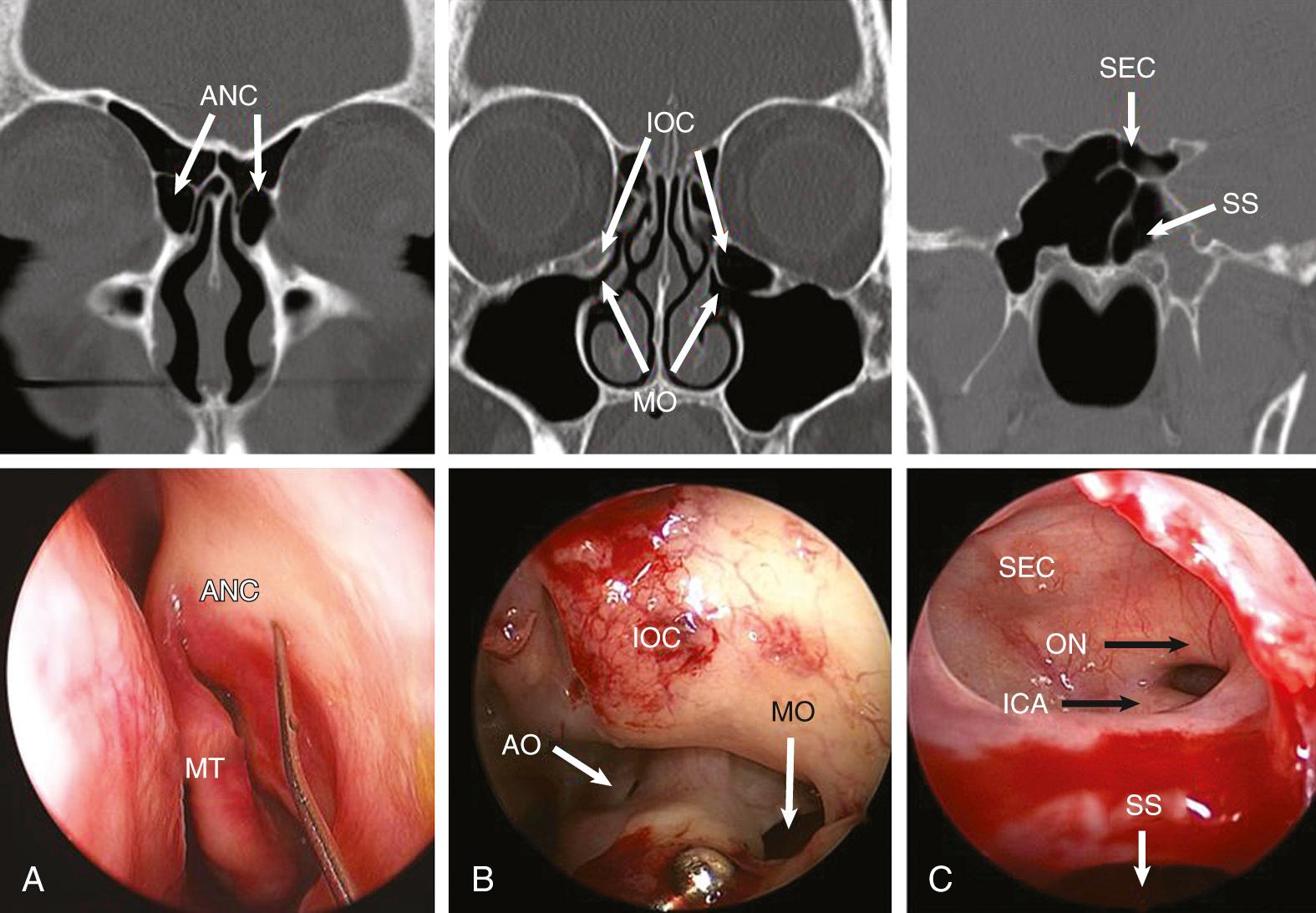
The infraorbital ethmoidal cell (IOC), previously called the Haller cell , is an anterior ethmoidal cell that pneumatizes into the orbital floor above the maxillary sinus ostium (see Fig. 44.5B ) and may compromise its patency. When this cell's common wall with the maxillary sinus ostium is not adequately resected, edema may develop, obstructing the maxillary sinus ostium. The lateral wall of the IOC may be attached to the infraorbital nerve canal and must, therefore, be removed carefully. Anterior ethmoidal cells in relationship to the frontal recess may impact its drainage and are discussed in detail with the frontal sinus anatomy.
The posterior ethmoidal complex consists of one to five cells that drain into the superior or the supreme meatus ( Figs. 44.6 and 44.7 ). When highly pneumatized, the posterior ethmoidal cells may extend above the orbit (supraorbital ethmoidal [SOE] cell) and above the sphenoid sinus. The sphenoethmoidal cell (SEC [Onodi cell]) is a posterior ethmoidal cell that pneumatizes superior and lateral to the sphenoid sinus. The sphenoid sinus lies inferomedial to the most posterior ethmoidal cell, including the SEC (Onodi cell) (see Fig. 44.5 ). Both the internal carotid artery (ICA) and the optic nerve can be exposed within the SEC (see Fig. 44.5C ).
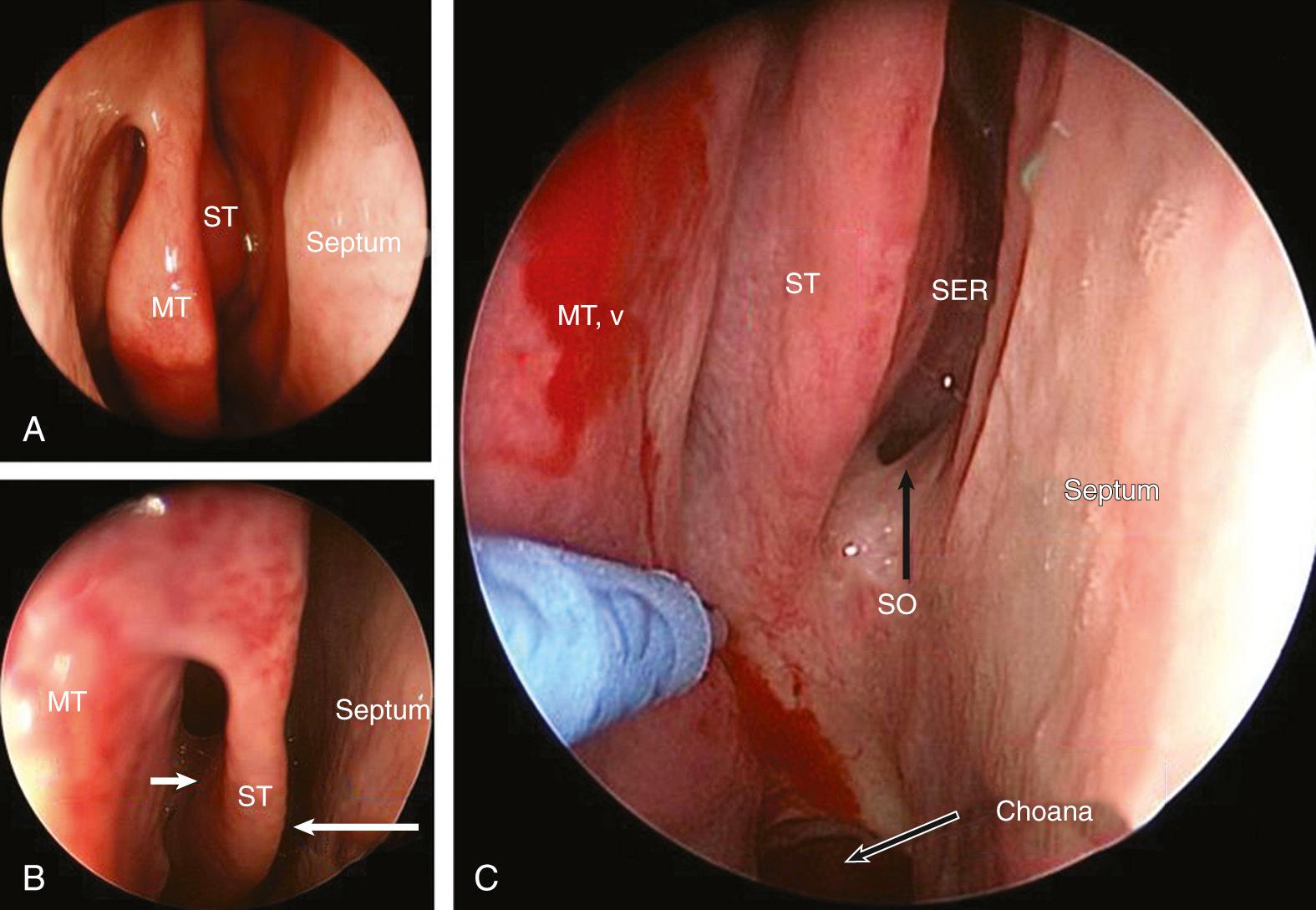
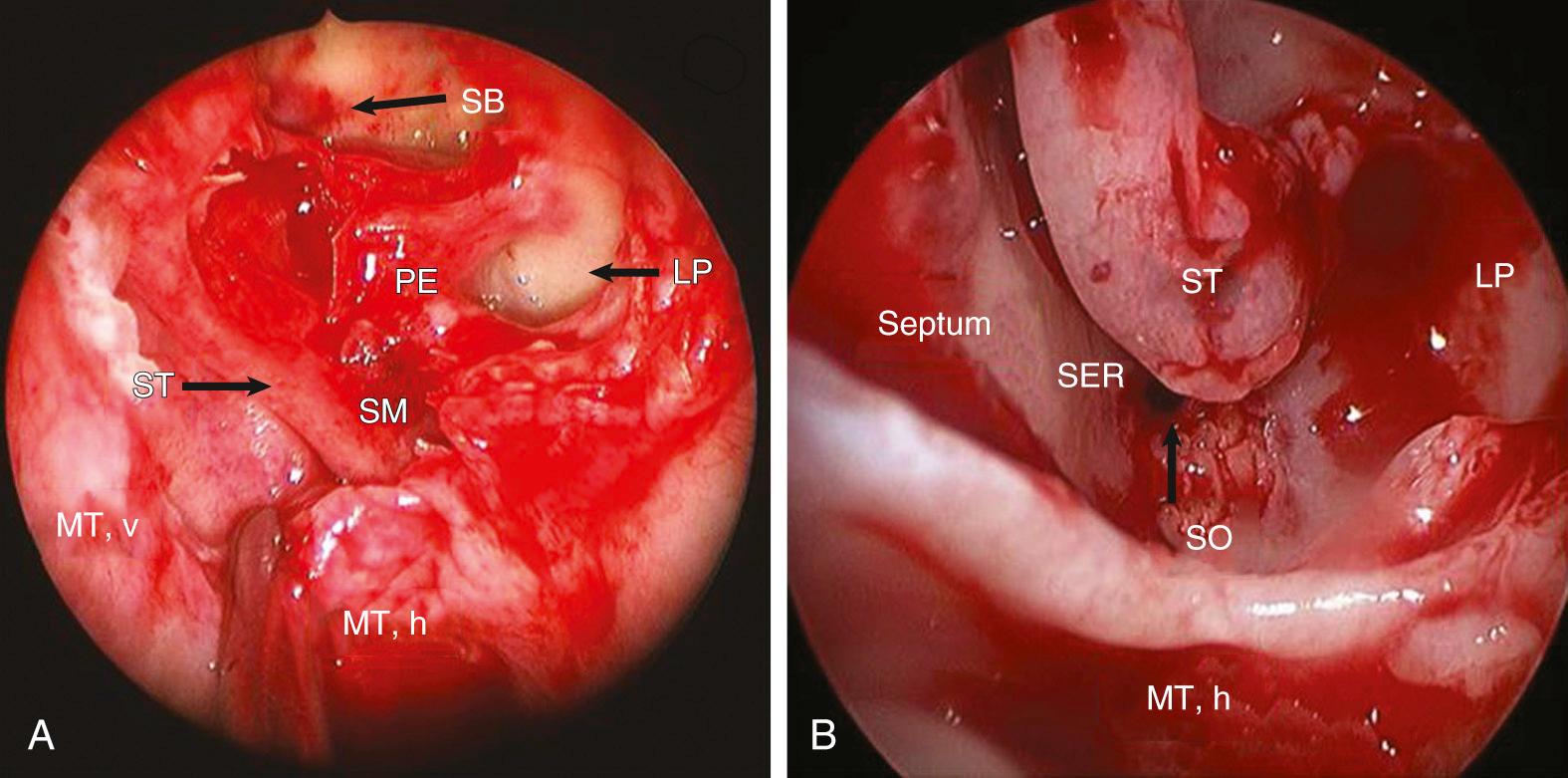
The natural ostium of the maxillary sinus (see Fig. 44.5B ) drains into the inferior aspect of the ethmoidal infundibulum at a 45-degree angle, and it is found just below the orbital floor in the medial wall of the sinus. It usually lies halfway between the anterior and posterior walls of the sinus. It is located in the superior third of the infundibulum in 10%, the middle third in 25%, and the inferior third in 65% of cases. The natural ostium is elliptically shaped; accessory ostia are round and are present in the fontanelles in at least 10% of patients. The lateral nasal wall has two areas where bone is absent between the mucosa, called fontanelles. One fontanelle is anterior to the uncinate bone (anterior fontanelle) and the other is posterior (posterior fontanelle) . Accessory ostia may occur in these areas of weakness (either in the anterior or posterior fontanelle) and must not be confused with the natural ostium, because the maxillary sinus mucus flow is always toward the natural maxillary ostium. It is most critical to understand that as the maxillary sinus ostium opens into the inferior aspect of the infundibulum, it can only be visualized on nasal endoscopy if the uncinate bone has been resected in that area. Openings in the medial maxillary wall that are visible in the presence of an intact uncinate process are likely to be accessory ostia opening through the anterior or posterior fontanelle area. Not incorporating the true maxillary sinus ostium into the surgical antrostomy remains the most common cause of failure of a maxillary antrostomy.
The sphenoid sinus ( Fig. 44.8 ) is the most posterior paranasal sinus. Its natural ostium opens into the sphenoethmoidal recess (SER). This recess lies medial and posterior to the superior turbinate, anterior to the anterior wall of the sphenoid, and medial to the nasal septum. Therefore, the sphenoid sinus natural ostium is consistently medial to the superior turbinate as reported by Millar and Orlandi, and consistently observed by this chapter's authors. Although some previous observations reported it to be lateral to the posterior end of the superior turbinate in 17% of cases, this may have been due to the stripping of the superior turbinate mucosa before measurements were taken. The sphenoid ostium is located approximately halfway to two-thirds up the anterior wall of the sinus and is always lower than the level of the maxillary roof. Following this endoscopic landmark, one can avoid inadvertent skull base penetration. The ostium has been described to lie at a distance of 6.2 to 8.0 cm (average 7.1 cm) from the nasal spine at an angle of 30 to 34 degrees with the floor (see Fig. 44.8 ). However, these distances can vary in patients and the surgeon must identify the natural ostium endoscopically to safely enter this sinus. The visualization of the lower half of the superior turbinate, staying surgically below the level of the maxillary sinus roof and just over the top of the horizontal basal lamella, is the most consistent endoscopic landmark for finding the sphenoid ostium. The sphenoid is surrounded by several critical structures such as the ICA, the optic nerve, and the skull base. Septations in the sphenoid frequently have attachments to the ICA, and if required, these septations must be removed carefully without any torsion to avoid injury to the artery.
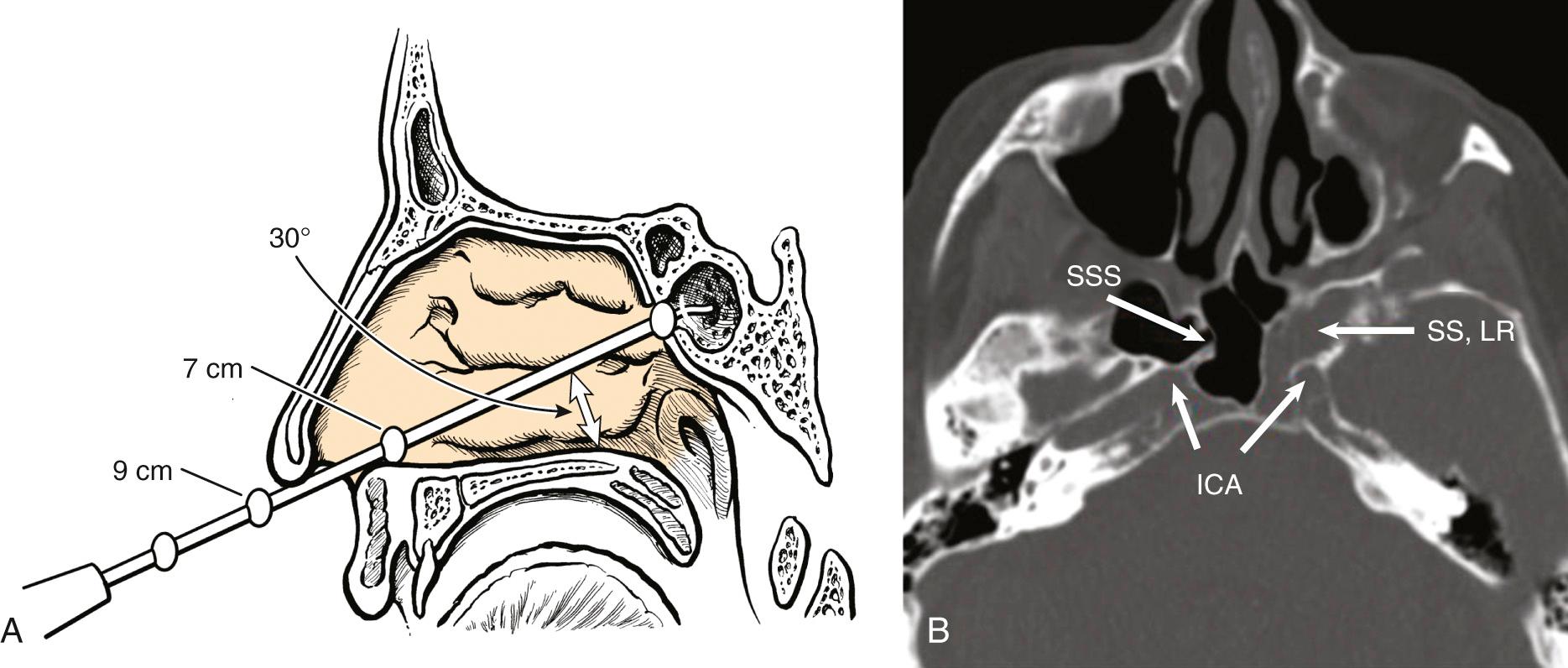
The frontal sinus originates embryologically from an anterior ethmoidal cell. The connection between the frontal sinus and anterior ethmoidal complex is not a tube or duct but an hourglass-shaped space or recess. The narrowest part of this has been conventionally called the “frontal ostium,” although this is truly not an ostium ( Fig. 44.9 ). The term “frontal opening” has been recently proposed as a more accurate substitute for “frontal ostium,” as the sinus does not have a true two-dimensional opening, but a continuous three-dimensional space that opens into the frontal recess inferiorly (see Fig. 44.3 ). The frontal sinus drains through the frontal recess into the middle meatus (commonly) or into the superior aspect of the infundibulum (less commonly; see Fig. 44.2 ). Messerklinger described frontal sinus mucociliary flow in 1955: mucus flows up the intersinus septum across the frontal sinus roof laterally, then medially along the floor to the frontal sinus ostium, and down into the frontal recess. An estimated 40% to 60% of this mucus flows back up the medial frontal recess wall to the intersinus septum and then recirculates up the intersinus septum to the roof. Consequently, drilling a hole in the intersinus septum or removing the lower part of it may not always be helpful.
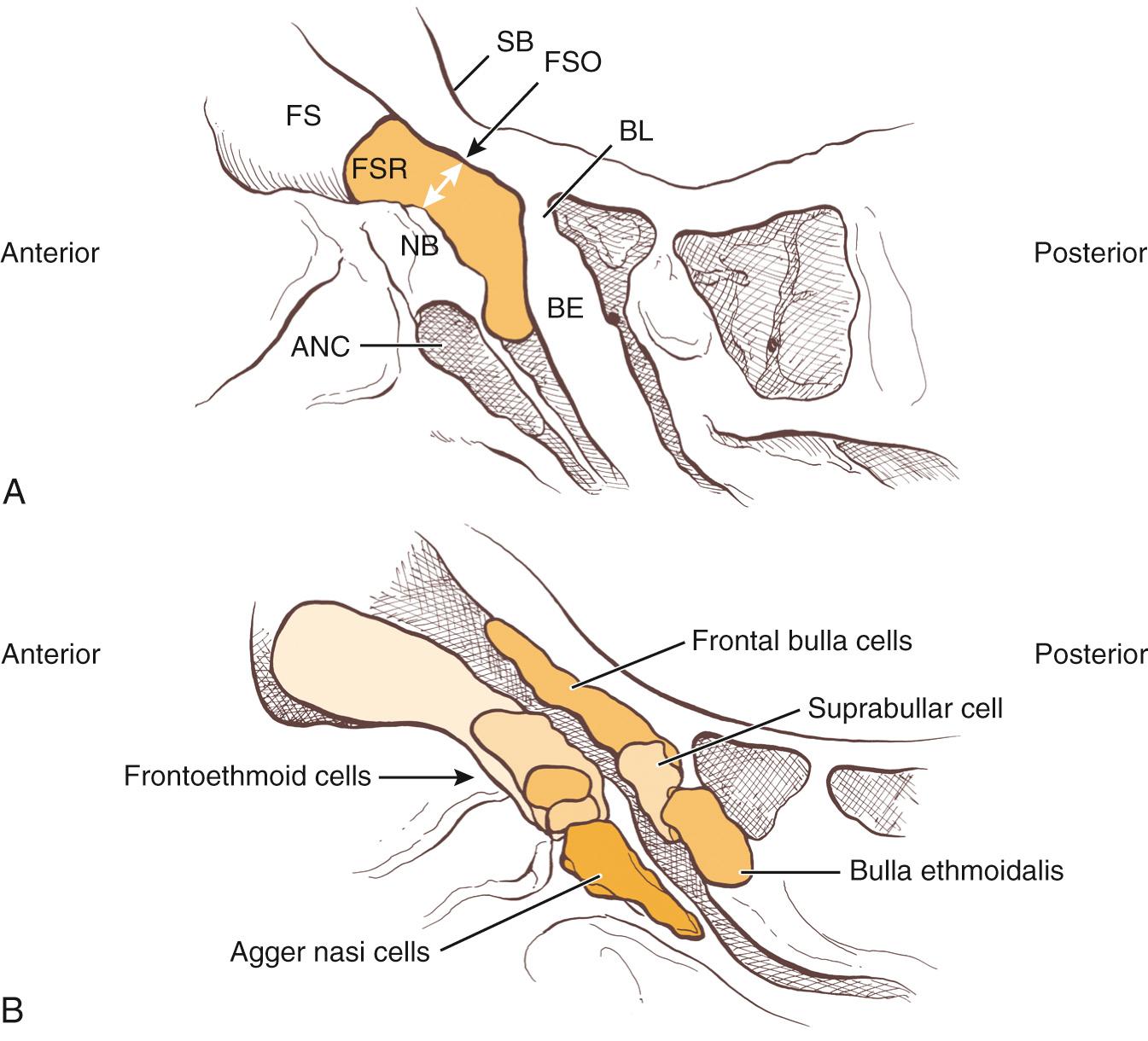
The terms “frontal recess” and “frontal sinus drainage pathway” refer to two separate anatomic entities. The frontal recess is the inferior part of the frontal sinus drainage pathway and lies inferior to the frontal ostium. The medial wall of the frontal recess is made by the most anterior part of the middle turbinate and its lateral wall is the lamina papyracea. In the simplest pattern of pneumatization, the anterior boundary of the frontal recess is the posterior wall of the ANC, and the posterior boundary is the ethmoidal bulla and the bulla lamella (see Fig. 44.9 ). The frontal sinus drainage pathway is frequently filled with various anterior ethmoidal cells, called frontal recess cells , which consequently narrow it.
Kuhn identified the common frontoethmoidal cells that pneumatize around the frontal recess ( Box 44.1 , Fig. 44.10 ; see also Fig. 44.9 ). Frontal cells lie anterior to the frontal recess, and the suprabullar, SOE, and frontobullar cells lie posterior to the frontal recess (see Fig. 44.9 ). The narrow convoluted drainage pathway out of the frontal sinus may easily be subject to obstruction by relatively minor swelling. A complex pattern of crowded frontal pneumatization can cause additional problems with frontal sinus drainage.
Frontal cells: Lie above the agger nasi and pneumatize anterior to the frontal sinus and recess (see Figs. 44.10 and 44.11 ). The name in brackets notes the International Frontal Sinus Anatomy Classification.
Type 1: A single cell superior to the agger nasi cell [agger nasi cell]
Type 2: A tier of two or more cells above the agger nasi cell [supra agger cell]
Type 3: A single cell that extends from the agger nasi cell into the frontal sinus, above the floor of the frontal sinus floor but less than 50% of the frontal sinus height [supra agger frontal cell]
Type 4: An isolated cell within the frontal sinus (Kuhn) or a single cell that extends into the frontal sinus for greater than 50% of the frontal sinus height (Wormald) [supra agger frontal cell]
Supraorbital ethmoidal cell (see Fig. 44.10 ): Cells posterior to the frontal sinus, pneumatizing superior to the orbital roof
Interfrontal sinus cell (see Fig. 44.10 ): Pneumatizes intersinus septum and drains into one frontal sinus, medial to the frontal ostium [frontal septal cell]
Suprabullar cell (see Fig. 44.9B ): Cell superior to the ethmoidal bulla [suprabullar cell]
Frontal bulla cell (see Fig. 44.9B ): Cell superior to the ethmoidal bulla pneumatizing into the posterior frontal table (anterior skull base) [suprabullar frontal cell]
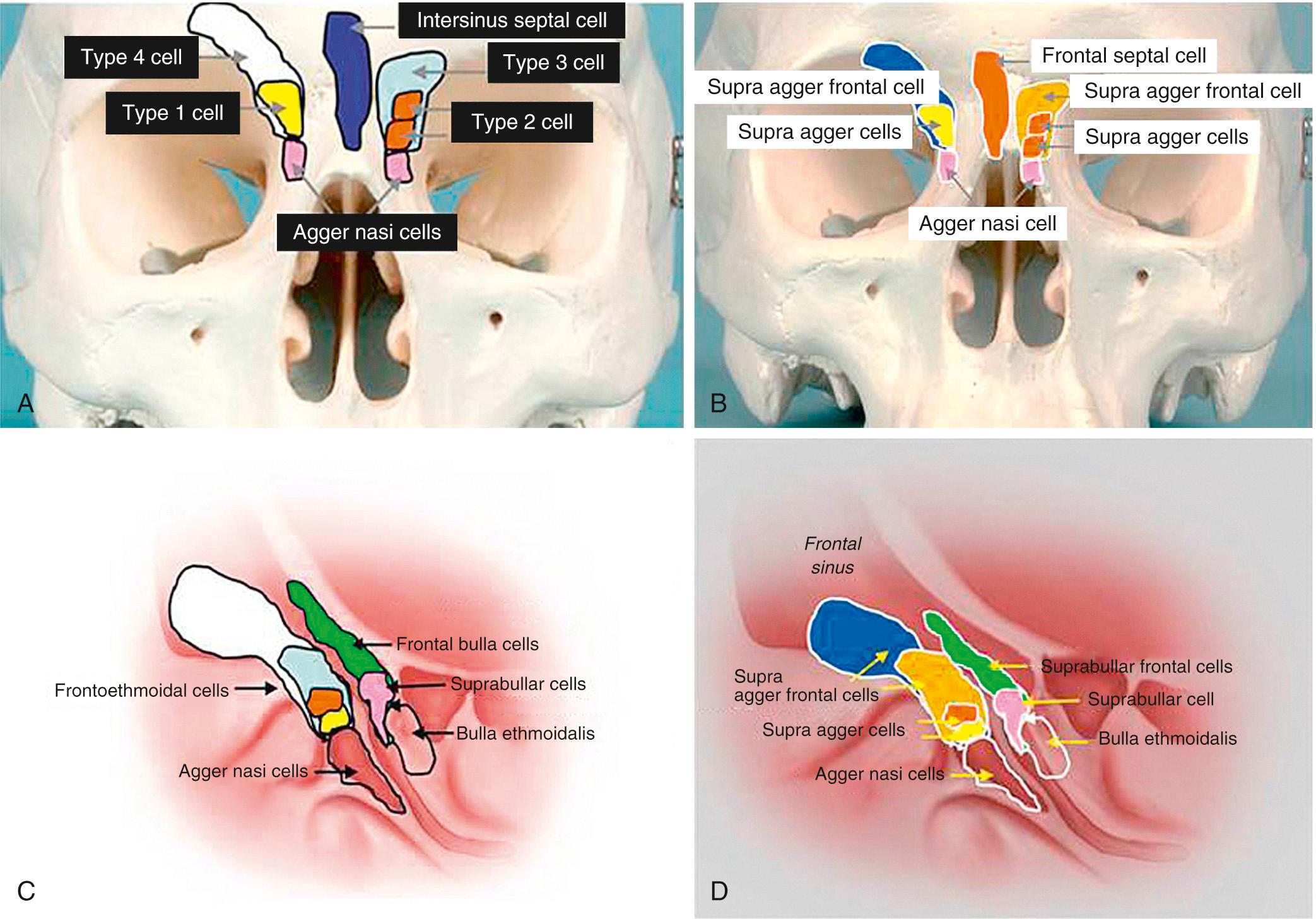
Although Kuhn described the type 4 cell as a single isolated cell within the frontal sinus with no apparent connection to the frontal recess, with modern imaging techniques that afford parasagittal sections, most type 4 cells are found to drain into the frontal recess area. Wormald has, therefore, suggested a modification in the Kuhn classification, defining a type 4 cell as one that extends into the frontal sinus for greater than 50% of the frontal sinus height and a type 3 cell as one that pneumatizes less than 50% of the height. Whereas most of these cells can be reached endoscopically, some, such as high type 4 cells, may require the addition of anterior frontal sinus trephination. A recent international consensus document was published in 2016 in an attempt to further simplify the classification of these cells. The cells that lie anterior to the frontal sinus drainage pathway are the ANC, the supra agger cells (Kuhn type 1 and Kuhn type 2 cells) and the supra agger frontal cells (Kuhn type 3 or Kuhn type 4 cells).
Cells behind the frontal recess are the ethmoidal bulla and suprabullar and frontal bullar (supra bullar frontal cell). These cells are depicted in Fig. 44.10 . The frontal recess anatomy must be studied in axial, coronal, and parasagittal views to construct a mental three-dimensional impression of the frontal sinus drainage pathway and account for these cells. On a coronal CT, the frontal sinus appears to be septated when SOE cells are present. Study of the CT scan in axial, coronal, and sagittal reconstructions will show that the lateral “frontal sinus cell” actually lies posterior to the frontal sinus and drains via a separate opening into the frontal recess, posterior and lateral to the true frontal ostium. SOE cells must be recognized to avoid missing the cell altogether or mistaking it for the true frontal sinus. Scarring may obstruct drainage of both the SOE and the frontal sinus due to not removing the partition that separates the SOE from the frontal sinus high enough to make a large common drainage chamber ( Fig. 44.11 ). The anterior ethmoidal artery is usually not present in the partition between the frontal sinus and the most anterior supraorbital cell, but running obliquely through a space behind that partition in the area of the bulla lamella. Dissection in this area must be done carefully to avoid injury to the anterior ethmoidal artery, which commonly is located in or below the skull base near the attachment of the bulla lamella. A pedicled ethmoidal artery is usually associated with the presence of hyperpneumatized ethmoidal cells.
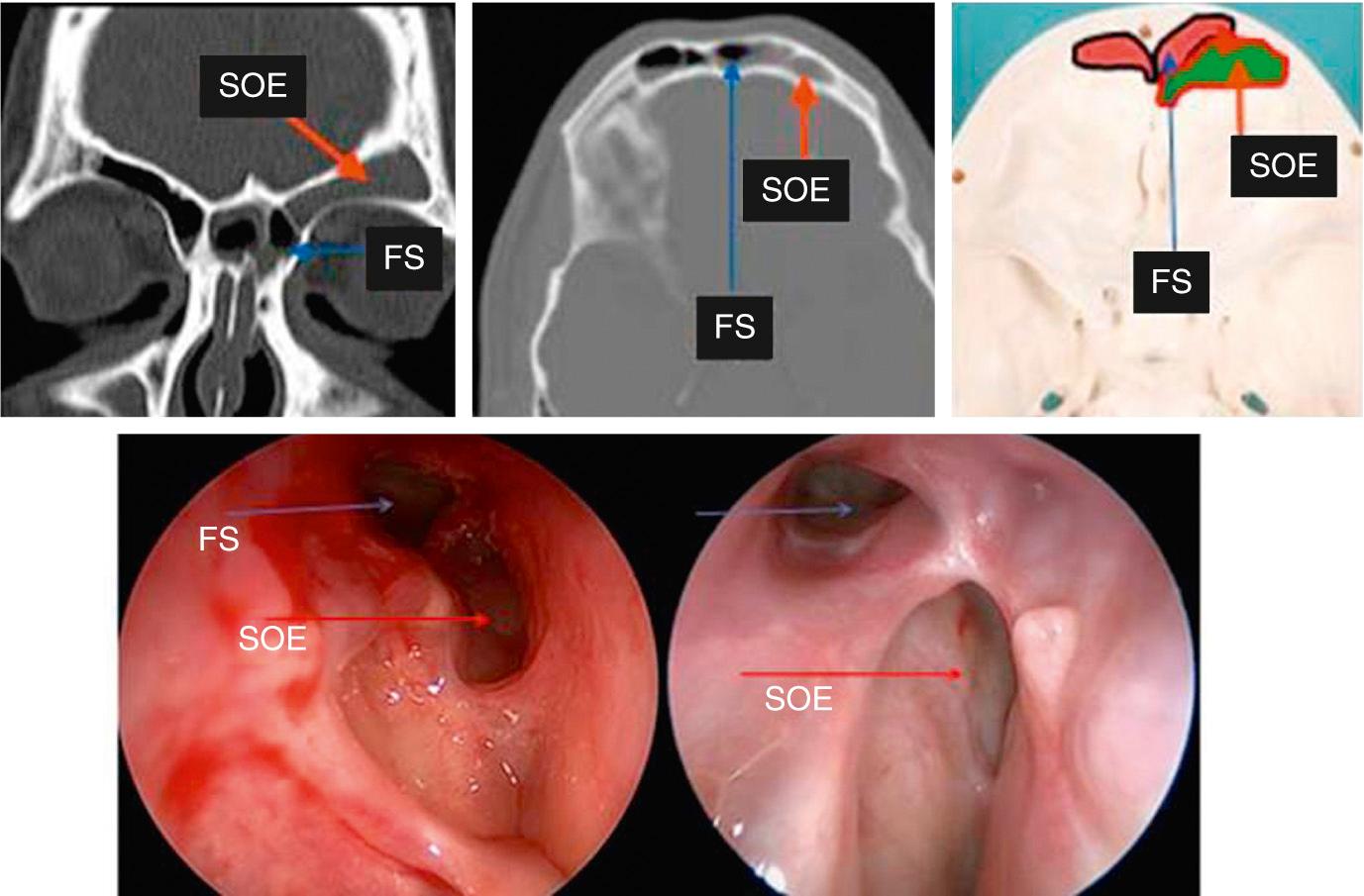
The anterior skull base is formed by the cribriform plate medially and the ethmoidal roof laterally. The term “fovea ethmoidalis” is occasionally used to refer to the ethmoidal roof, but is a misnomer as this area has no “fovea.” The cribriform plate has a medial part and a lateral lamella. The ethmoidal roof is much thicker than the cribriform area and extends laterally from the lateral lamella of the cribriform plate to the orbit, forming the roof of the ethmoidal sinuses. The cribriform plate may be only 0.1 to 0.2 mm thick and may lie much lower than the ethmoidal roof. Keros classified the skull base into three types, according to the depth (shallow, medium, or deep) of the olfactory groove: type 1 is 1 to 3 mm, type 2 is 4 to 7 mm, and type 3 is 8 to 16 mm. Because the very thin lateral lamella forms most of the steeply inclined ethmoidal roof in a type 3 configuration, patients with this configuration are especially vulnerable to penetration of the anterior skull base during ESS ( Fig. 44.12A ). The cribriform area can also have asymmetric heights on either side of the nose. A recent study utilizes the ratio of posterior ethmoidal cell height to the maxillary sinus height for assessing the height of the posterior ethmoidal skull base. If the maxillary sinus is high, the posterior ethmoid is lower and suggests a lower-lying skull base. The anterior skull base is the highest anteriorly and slopes downward posteriorly, a fact that becomes important during ethmoidectomy and transethmoidal sphenoid sinusotomy. The surgeon should dissect low through the ethmoids until the skull base is identified. The ethmoidal partitions are then removed from the skull base in a posterior to anterior direction, pulling forward away from the skull base rather than pushing back into it. Before the skull base has been formally identified, staying below the level of the maxillary roof can help avoid inadvertent penetration of the skull base in the posterior ethmoidal cells and sphenoid sinus. The anterior ethmoidal artery lies posterior to the frontal recess, usually behind the most superior anterior ethmoidal cell. In most cases, these vessels are enclosed in the skull base and are not visible, but sometimes, they can lie pedicled or slinging downward within a mesentery within the ethmoidal space. Preoperative survey of the coronal CT scan can identify low-lying ethmoidal arteries. The posterior ethmoidal artery can be identified in the skull base just anterior to the sphenoid sinus. It is important to not transect the ethmoidal arteries to prevent their retraction into the orbit, which could cause formation of an acute orbital hematoma and result in blindness (see Fig. 44.12B ), although fortunately, such injury is rare. If traumatized, these vessels should be cauterized with a bipolar cautery device to avoid intracranial or intraorbital retraction and bleeding. The use of monopolar cautery or injudicious cauterization may also cause injury to the skull base and create a cerebrospinal fluid (CSF) leak.
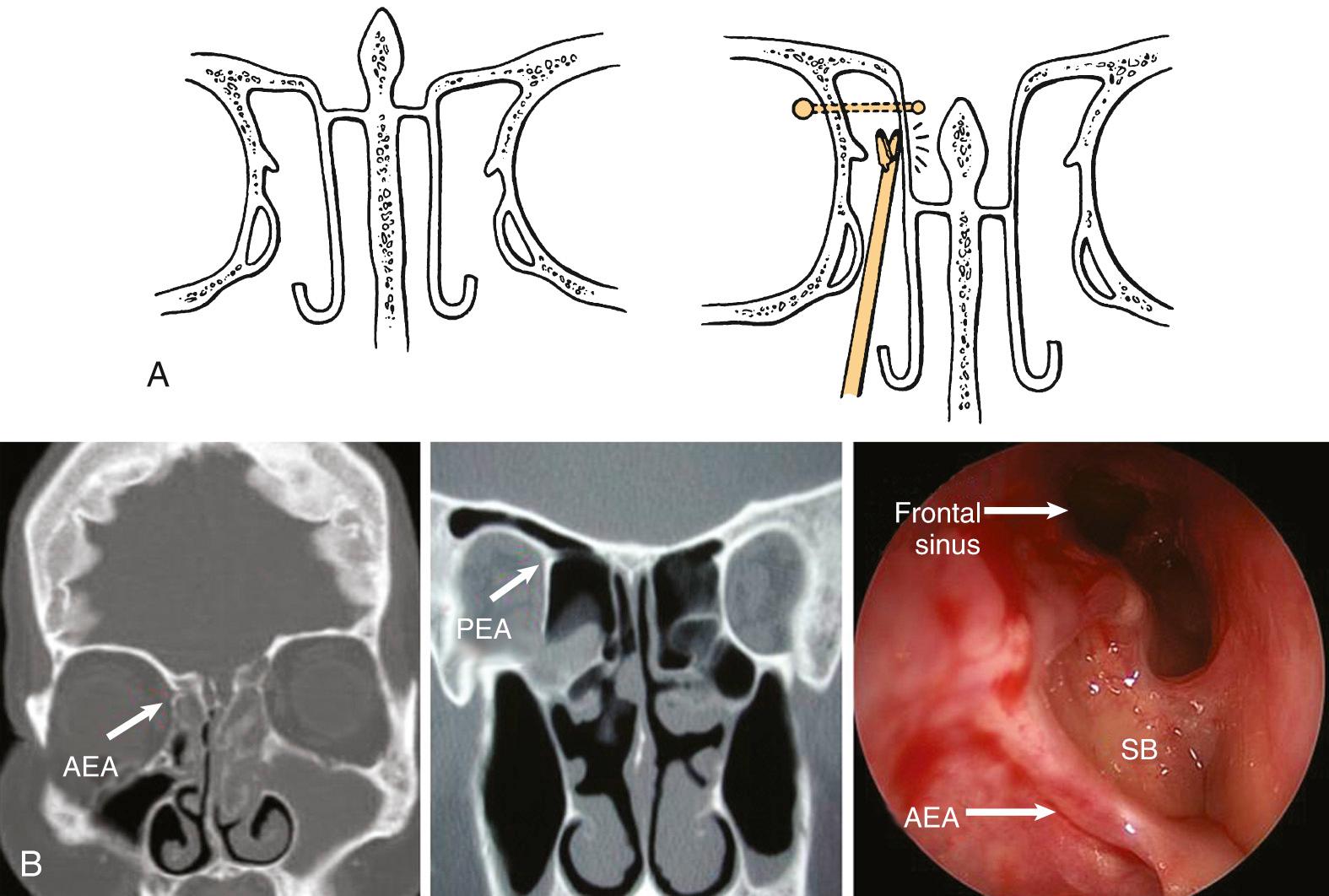
Anatomic variations include structures such as a concha bullosa, ANCs, infraorbital (Haller) cells, sphenoethmoidal (Onodi) cells, and paradoxical middle turbinates. Concha bullosa is the term used for an aerated middle turbinate or a cell found within the middle turbinate. These structures appear as a widened area of the middle turbinate, and they may obstruct the OMC. In the absence of a history of rhinosinusitis, the incidental finding of a widened middle turbinate during endoscopy or a concha bullosa on CT does not mandate further investigation. Most patients with such variations remain asymptomatic. In a review of 172 coronal sinus CT scans, a concha bullosa was found in 28% of patients with sinus disease and in 26% of patients without. Middle turbinate pneumatization may be in just the vertical portion, which is difficult to resect. A pneumatized uncinate is rare but can contribute to OMC obstruction. Pneumatized inferior and superior turbinate concha bullosa are also rare and have unknown clinical significance. However, recognition of these rare patterns is important during surgical resection to avoid confusion ( Fig. 44.13 ).
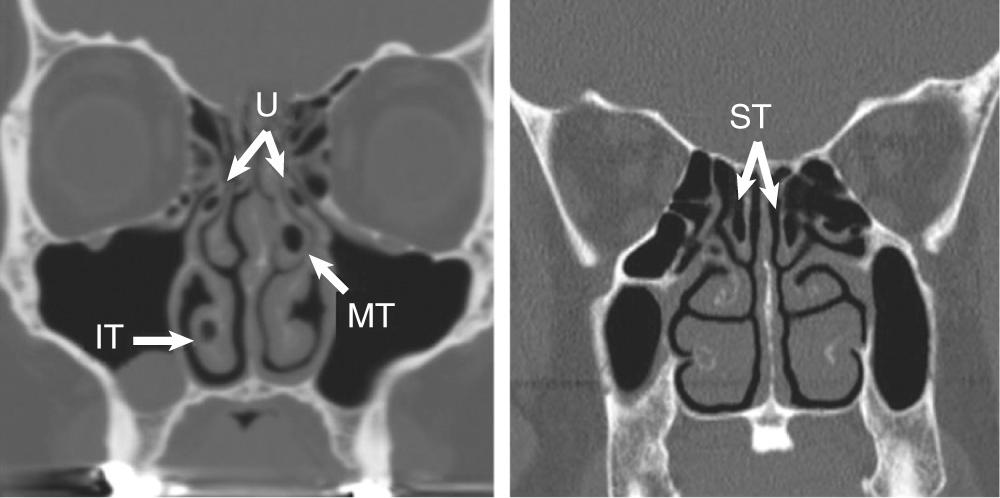
There is no absolute indication for ESS for any inflammatory, uncomplicated sinonasal disease. In contrast, surgery may be mandated in certain sinonasal conditions such as impending orbital or intracranial complications, invasive fungal rhinosinusitis (IFRS), CSF rhinorrhea, sinonasal tumors, and expansile mucoceles and polyps that cause orbital or skull base erosion. There is no absolute contraindication to the endoscopic approach, although the decision to use an external or an endoscopic approach depends on the exposure needed, availability of instruments, as well as the surgeon's training and experience. In the contemporary era, primary sinus surgery is almost exclusively performed endoscopically, with external or headlamp-guided procedures being rarely used. Box 44.2 lists the sinonasal disease processes for which surgery may be indicated.
Chronic rhinosinusitis (with or without nasal polyposis)
Recurrent acute rhinosinusitis
Complications of rhinosinusitis
Antrochoanal polyps
Noninvasive fungal ball and eosinophilic fungal rhinosinusitis
Invasive fungal rhinosinusitis
Mucoceles
Silent sinus syndrome
Intractable epistaxis
Cerebrospinal fluid rhinorrhea and anterior meningoencephaloceles
Foreign body removal
Choanal atresia repair
Headaches and facial pain
Sinonasal tumors
Expanded transnasal approaches to the skull base and orbit
CRS that is recalcitrant to medical therapy is the most common indication for surgery. Surgery is indicated in symptomatic patients in whom appropriate medical therapy has failed. Surgery is adjunctive to medical therapy. Especially in CRS with nasal polyps (CRSwNP), long-term maintenance medical therapy and intermittent escalated therapy may be necessary despite surgery to control disease and symptoms. However, ESS is effective in symptom-control, disease control, as well as in decreasing health care utilization for CRS, a costly disease (see Chapter 43 ). Recent studies have investigated the efficacy of continued medical therapy versus early surgery in patients with CRS. Recent studies from the United Kingdom show that delay in surgery may impact sinonasal outcomes and asthma prevalence adversely. Surgery for CRS without nasal polyps (CRSsNP) is directed to relieving obstruction in the OMC, thus improving drainage and ventilation in the sinuses with a goal to restore mucociliary function. Surgery may be curative in some forms of CRSsNP such as odontogenic sinusitis.
CRSwNP is not necessarily secondary to ostiomeatal obstruction, and is often driven by eosinophilic inflammation in the United States. CRSwNP may be recalcitrant to medical therapy as well as surgery. In these patients, the goal of surgery is to remove polyps and associated debris and mucin but following the fundamental principles of ESS (mucosal preservation and function restoration). For these patients, a critical role of surgery is provision of wide passages for not only sinus ventilation and drainage but the delivery of topical medical therapy and office-based debridements. Most critical to this is a thorough and complete ethmoidectomy. Studies show that ESS is necessary to deliver topical medical therapy as there is virtually no penetration of topical nasal agents into unoperated sinus cavities. CRSwNP are commonly diagnosed in association with asthma, allergic fungal rhinosinusitis (AFRS), and aspirin-exacerbated respiratory disease (or the Samter triad: nasal polyps, asthma, and aspirin sensitivity); these disease entities can be recalcitrant and very difficult to treat and impact outcomes. A detailed description of the pathophysiology of CRS is beyond the scope of this chapter. However, a thorough understanding of the pathophysiology is key to treating CRS; surgery should be personalized to address both patient symptoms and the disease subtype (see Chapter 41 ).
An antrochoanal polyp arises from the maxillary antrum and extends posteriorly to the choana, usually through the posterior fontanelle, and causes nasal obstruction. This is a relative indication for surgery. Antrochoanal polyps are solitary, unilateral lesions that arise from the maxillary sinus and grow toward the choana. They must be differentiated by imaging or biopsy characteristics from neoplastic processes prior to undertaking “polypectomy.” If removed completely along with the antral part, these polyps are unlikely to recur. A supplementary sublabial, transcanine, or inferior meatus approach may be necessary in some patients. The traditional Caldwell-Luc surgery is not necessary (i.e., stripping of the maxillary sinus mucosa) for these polyps. The creation of a small, temporary endoscopic inferior meatal antrostomy for endoscopy or instrumentation can improve access to the polyp and will usually scar down. Extension of the middle meatal antrostomy to the floor of the nasal cavity by resecting the midsegment of the inferior turbinate (mega-antrostomy) may be another option. Endoscopes and curved powered or grasping instruments are very helpful in the removal of the maxillary portion of the polyp, which is the key to avoiding failure.
Surgery may be indicated for patients with recurrent acute rhinosinusitis, defined as four or more clinical episodes annually. Disease should be confirmed by means of at least one objective criterion (endoscopically or on CT scan) while the patient is symptomatic. A positive CT scan or nasal endoscopy at the time of infection should be ascertained before any surgical intervention is undertaken. Many noninflammatory disorders such as migraines and other headache disorders can be frequently present with a heavy burden of sinonasal symptoms and can be misdiagnosed as recurrent acute rhinosinusitis.
Acute complications, both orbital and intracranial, that are unresponsive to medical therapy require immediate surgical intervention. External procedures have been used in the past, because nasal edema and inflammation can compromise visualization during an endoscopic exposure. However, with experience, ESS is safe and effective in managing such situations.
Mucoceles are epithelial-lined, mucus-containing sacs that completely fill a paranasal sinus. They are expansile and cause bony erosion; therefore, they must be removed or drained to prevent intracranial and orbital complications. Mucoceles are more commonly found in the frontal and ethmoidal sinuses, although isolated sphenoid mucoceles have been reported. In the past, open approaches have been used to completely remove the lining of the mucocele. However, this practice can be dangerous, because mucoceles can erode through the skull base or through the lamina papyracea into the orbit. Endoscopic management with marsupialization is preferable and safer, because complete removal of the cyst lining is not required. Although technically more challenging, this latter approach is very effective, with low recurrence rates. The surgical goal in treatment of a mucocele is to widely open it to allow for drainage (marsupialization) in a safe fashion, bearing in mind that mucoceles often cause skull base or orbital dehiscences. Care must be taken to prevent scarring to avoid recurrence. The use of intraoperative image-guided navigation systems may help in identifying and safely opening mucoceles.
Uncontrolled posterior epistaxis can be controlled with endoscopic assistance in identification of the bleeding vessel; this subject is described in Chapter 47 .
Endoscopic repair is now a standard approach for repair in cases of CSF rhinorrhea and meningoencephaloceles, with success rates higher than 90%. CSF rhinorrhea and meningoencephaloceles are both described in detail in Chapter 48 .
Noninvasive fungal sinusitis includes “fungal ball” and “allergic fungal sinusitis.” Fungus balls can occur in any paranasal sinus. The treatment is removal of the debris by ESS. A large antrostomy or ostioplasty is created, and fungal debris is irrigated and removed. Usually, no further medical therapy is required. The presence of associated sclerotic and osteolytic changes in the affected sinus should alert the physician to the chronicity of this pathology. Patients with dense osteitic changes in the sinuses, especially in hypoplastic sphenoid sinus often show tendency for stenosis of the surgical neo-ostium.
AFRS is usually treated with a combination of ESS, medical therapy, and immunotherapy. Patients with histopathologic evidence of AFRS without elevated immunoglobulin E (IgE) to fungus are classified as having nonallergic fungal rhinosinusitis (NAEFRS). Clinically, patients with AFRS are atopic, and may have nasal polyps and comorbid asthma. Surgical management specific to AFRS is detailed later in the chapter under the section of surgery for CRSwNP.
IFRS is almost exclusively a disease of the severely immunocompromised. All avascular and necrotic tissue must be debrided until healthy, bleeding tissue is encountered. Serial debridements may be necessary every 2 to 3 days, and the disease is kept under stringent surveillance by serial endoscopy and radiographic imaging. An open approach can be combined in extensive disease or with involvement of the skin, subcutaneous tissue, or bone (nasal, palatine, and maxillary). The prognosis remains grim in spite of optimal debridement by any approach, because patients have multisystemic comorbidities. Therapy for IFRS requires reversal of the underlying predisposing condition, systemic antifungal therapy (initial broad spectrum followed by culture-directed antifungals), and surgical debridement. Ability to reverse underlying immunodeficiency is critical to survival. If the immunocompromised status is profound and irreversible, any surgical treatment is unlikely to be successful; in these patient subsets, mutilating and painful therapy should be avoided. IFRS in the immunocompetent patient is rare, and the course is generally chronic, although it may still be lethal. Chronic IFRS includes both granulomatous and nongranulomatous subtypes, and surgical management is similar in philosophy to treatment for acute FRS.
Become a Clinical Tree membership for Full access and enjoy Unlimited articles
If you are a member. Log in here